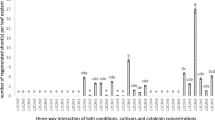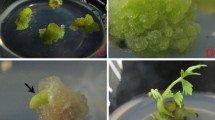Abstract
An efficient micropropagation system for Pinellia ternate (Thunb) Briet, a traditional Chinese medicinal plant, has been developed. Petiole and lamina of P. ternate were used as explants and cultured on Murashige and Skoog (MS) medium containing different concentrations of different plant growth regulators. The results indicated that low concentration of 2,4-dicholorophenoxy acetic acid (2,4-D), indole-3-acetic acid (IAA) and α-naphthalene acetic acid (NAA) were suitable for micro-tuber induction, but callus induction rate increased with increasing concentrations of growth regulators. Tubers induction rates of petiole and leaf were (81.8 %–100 %) and (89.4 %–96.0 %) respectively, when 0.2 mg l−1 2, 4-dicholorophenoxy acetic acid, indole-3-acetic acid or α-naphthalene acetic acid were present in the medium. Tubers induction rates of petiole and leaf cultured on MS medium supplemented with 0.2–0.5 mg l−1 6-benzyl amino purine (6-BAP) were (94.1 %–100 %) and (96.0 %–100 %) respectively. When the concentration of 2,4-dicholorophenoxy acetic acid, α-naphthalene acetic acid and 6-benzyl amino purine was increased to 2.0 mg l−1, callus induction rates of petiole and leaf were 100 % and 98.2 %, 91.0 % and 36.0 %, 62.3 % and 70.0 %, respectively. Different concentration of kinetin (KT) and zeatin (ZT) had no significant effect on micro-tuber induction of petiole. Most petioles showed polarity during the cultivation of explants, when supplemented with different concentrations of auxin or cytokinin in the MS medium.
Similar content being viewed by others
References
Chang L, Xu YM and Xue JP (2007). Formation of microtubers from the petiole of Pinellia ternate (Thunb.) Berit. in vitro and change of endogenous hormones content (Chinese). Journal of Huazhong Agricultural University, 26(5): 612–615.
Chen FQ, Fu Y, Wang DL, Gao X and Wang L (2007). The effect of plant growth regulators and sucrose on the micropropagation and microtuberization of Dioscorea nipponica Makino. Journal of Plant Growth Regulation, 26: 38–45.
Chen JH, Cui GY, Liu JY and Tan RX (2003). Pinelloside, an antimicrobial cerebroside from Pinellia ternate. Phytochemistry, 64: 903–906.
Dhandapani M, Doo Hwan Kim and Seung Beom Hong (2008). Efficient plant regeneration via somatic embryogenesis and organogenesis from the explants of Catharanthus roseus. In vitro Cells Dev. Biol.-Plant, 44: 18–25.
Drugs Institute of Chinese Academy of Medical Sciences (1993). History of Chinese Medicine (book 2) (Chinese). People’s Health Press, Beijing 28–29.
Fan MH, Zhou JY, Peng Y and Liu SN (2005). Effect of induction and proliferation of callus of Pinellia ternate (Chinese). Journal of Shandong Chinese Medicine, 24(3): 168–171.
Han MH, Yang XW, Zhang M and Zhong GY (2006). Phytochemical study of the rhizome of Pinellia ternate and quantification of phenylpropanoids in commercial Pinellia tuber by RP-LC. Chromatographia, 64: 647–653.
Lin J, Yao JH, Zhou XW, Sun XF and Tang KX (2003). Expression and purification of a novel mannose-binding lectin from Pinellia ternate. Molecular Biotechnology, 25: 215–221.
Jarvis BC, Shannon PRM and Yasmin S (1983). Influence IBA and cordyeepin on rooting and RNA synthesis in stem cutting of Phaseolus arureus Roxb. Plant Cell Physiol., 24: 139–142.
Lee YI and Lee N (2003). Plant regeneration from protocorm-derived callus of Cypripedium formosanum. In Vitro Cell. Dev. Biol.-Plant, 39: 475–479.
Li XL and Wang XM (2008). Study on the rapid-propagation technical system with the petioles of Pinellia ternate Breit as explants. Journal of Anhui Agricultural Sciences, 36(6): 2247–2248.
Luo CK and Peng ZS (2005). Induction of pultaceous callus in Pinellia ternate (Chinese). Journal of China West Normal University (Natural Science), 26(1): 37–43.
Luo GM, Liu XW, Yao ZS, Lai XW and Ge F (2000). Tissue culture and regeneration of Pinellia ternate (Chinese). Journal of Jiangxi College of Traditional Chinese Medicine, 12(3): 125–126.
Makunga NP and Staden JV (2008). An efficient system for the production of clonal plantlets of the medicinally important aromatic plant: Salvia africana-lutea L. Plant Cell Tiss Organ Cult., 92: 63–72.
Murugesan D, Doo HK and Seung-Beom H (2008). Efficient plant regeneration via somatic embryogenesis and organogenesis from the explants of Catharanthus roseus. In Vitro Cell. Dev. Biol.-Plant, 44: 18–25.
Mao ZC and Peng ZS (2003). Progress on research of rapid propagation system of Pinellia ternate (Chinese). China Journal of Chinese Materia Medica, 28(3): 193–195.
Murashige T and Skoog F (1962). A revised medium for rapid growth and bioassays with tobacco tissue cultures. Physiol. Plant, 15: 473–497.
Peng ZS, Luo CK, Cai P, Mao ZC, Kang CY and Yang J (2007). Rapid propagation of the medicinal plant Pinellia ternate by in vitro leaves culture. Bulgarian Journal of Agricultural Science, 13: 1–6.
Ren JH, Chen KR and Xu QF (1983). Organ induction of trefoil Pinellia ternate (Chinese). Plant Physiology Communications, (4): 44–45.
Shoyama Y, Hatano K and Nishioka I (1983). Clonal Multiplication of Pinellia ternate by Tissue Culture. Planta Med., 49(1): 14–l6.
Wang JL, Liao XR, Zhang HM, Du JF and Chen PL (2003). Accumulation of chlorogenic acid in cell suspension cultures of Eucommia ulmoides Oliv. Plant Cell Tiss Organ Cult., 74(2): 193–195.
Xu XM, Lu DX, Sun M, Zhang M and Chen M (2005). Clustered shoot induction and rapid propagation on Pinellia ternate (Chinese). Journal of Chinese Medicinal Materials, 28(12): 1052–1053.
Xue JP, Zhang AM, Ge HL and Sheng W (2004). Technique on artificial seeds of Pinellia ternate (Chinese). China Journal of Chinese Materia Medica, 29(5): 402–405.
Yu Y and Wei ZM (2008). Increased oriental armyworm and aphid resistance in transgenic wheat stably expressing Bacillus thuringiensis (Bt) endotoxin and Pinellia ternate agglutinin (PTA). Plant Cell Tiss Organ Cult., 94: 33–44.
Zeng LB, Zhou JY, Zhao J and Xiong L (1995). Effects of different plant growth regulator on morphogenetic in tissue culture of Pinellia ternate (Chinese). Journal of Anhui Normal University, 18(3): 42–46.
Zhang AM, Yang SY, Xue JP, Sheng W, Gao X and Zhu YF (2005). Effects of different factors on direct induction of microtubers from explants in Pinellia ternate (Chinese). China Journal of Chinese Materia Medica, 30(8): 576–579.
Zhang XW, Wang XF and Zhang XC (2006). Research advances on Pinellia ternate (Chinese). Research and Practice on Chinese Medicines, 20(6): 57–61.
Author information
Authors and Affiliations
Corresponding author
Rights and permissions
About this article
Cite this article
Wang, J., Wang, Q., Wang, J. et al. Effect of different plant growth regulators on micro-tuber induction and plant regeneration of Pinellia ternate (Thunb) Briet. Physiol Mol Biol Plants 15, 359–365 (2009). https://doi.org/10.1007/s12298-009-0040-8
Published:
Issue Date:
DOI: https://doi.org/10.1007/s12298-009-0040-8




